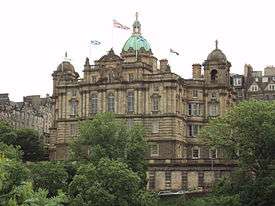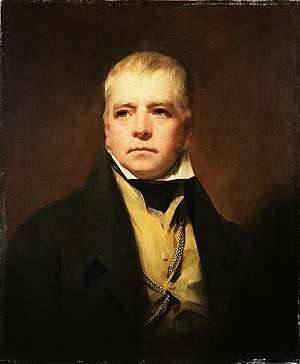Bank of Scotland
The Bank of Scotland plc (Scots: Bank o Scotland, Scottish Gaelic: Banca na h-Alba)[2] is a commercial and clearing bank based in Edinburgh, Scotland. With a history dating to the 17th century, it is the fifth-oldest extant bank in the United Kingdom (the Bank of England having been established one year earlier), and is the only commercial institution created by the Parliament of Scotland to remain in existence. It was one of the first banks in Europe to print its own banknotes, and it continues to print its own sterling banknotes under legal arrangements that allow Scottish banks to issue currency.
| Public limited company | |
| Industry | Finance and Insurance |
| Founded |
|
| Headquarters | The Mound, , Scotland, United Kingdom |
| Products | Financial services |
Number of employees | 20,000 |
| Parent | Lloyds Banking Group |
| Divisions | |
| Website | www |
In June 2006, the HBOS Group Reorganisation Act 2006 was passed by the Parliament of the United Kingdom, allowing the bank's structure to be simplified. As a result, The Governor and Company of the Bank of Scotland became Bank of Scotland plc on 17 September 2007.
Bank of Scotland has been a subsidiary of Lloyds Banking Group since 19 January 2009, when HBOS was acquired by Lloyds TSB.
History
Establishment
The Governor and Company of the Bank of Scotland was established by an Act of the Parliament of Scotland on 17 July 1695,[3] the Act for erecting a Bank in Scotland, opening for business in February 1696. Although established soon after the Bank of England (1694), the Bank of Scotland was a very different institution. Where the Bank of England was established specifically to finance defence spending by the English government, the Bank of Scotland was established by the Scottish government to support Scottish business, and was prohibited from lending to the government without parliamentary approval.[3] The founding Act granted the bank a monopoly on public banking in Scotland for 21 years, permitted the bank's directors to raise a nominal capital of £1,200,000 pound Scots (£100,000 pound sterling), gave the proprietors (shareholders) limited liability, and in the final clause (repealed only in 1920) made all foreign-born proprietors naturalised Scotsmen "to all Intents and Purposes whatsoever".[3] John Holland, an Englishman, was one of the bank's founders.[3] Its first chief accountant was George Watson.[4]
18th and 19th centuries
The Bank of Scotland was suspected of Jacobite sympathies.[3] Its first rival, the Royal Bank of Scotland, was formed by royal charter in 1727.[3] This led to a period of great competition between the two banks as they tried to drive each other out of business.[3] Although the "Bank Wars" ended in around 1751,[3] competition soon arose from other sources, as other Scottish banks were founded throughout the country.[3] In response, the Bank of Scotland itself began to open branches throughout Scotland. The first branch in London opened in 1865.[5]
The bank also took the lead in establishing the security and stability of the entire Scottish banking system, which became more important after the collapse of the Ayr Bank in 1772,[6] in the crisis following the collapse of the London house of Neal, James, Fordyce and Down. The Western Bank collapsed in 1857, and the Bank of Scotland stepped in with the other Scottish banks to ensure that all the Western Bank's notes were paid.[7] See Credit crisis of 1772.
20th century
In the 1950s, the Bank of Scotland was involved in several mergers and acquisitions with different banks. In 1955, the Bank merged with the Union Bank of Scotland.[8] The Bank also expanded into consumer credit with the purchase of Chester based, North West Securities (now Capital Bank).[9] In 1971, the Bank agreed to merge with the British Linen Bank,[9] owned by Barclays Bank. The merger saw Barclays Bank acquire a 35% stake in the Bank of Scotland, a stake it retained until the 1990s. The merchant banking division of the Bank of Scotland was relaunched as British Linen Bank (now known as HBOS Treasury Services).
In 1959 Bank of Scotland became the first bank in the UK to install a computer to process accounts centrally.[9] At 11 am on 25 January 1985 the Bank introduced HOBS (Home and Office Banking Services), an early application of remote access technology being made available to banking customers. This followed a small-scale service operated jointly with the Nottingham Building Society for two years but developed by Bank of Scotland. The new HOBS service enabled customers to access their accounts directly on a television screen, using the Prestel telephone network.
International expansion
The arrival of North Sea oil to Scotland in the 1970s allowed the Bank of Scotland to expand into the energy sector. The Bank later used this expertise in energy finance to expand internationally. The first international office opened in Houston, Texas, followed by more in the United States, Moscow and Singapore. In 1987, the Bank acquired Countrywide Bank[9] of New Zealand (later sold to Lloyds TSB in 1998). The Bank later expanded into the Australian market by acquiring the Perth-based Bank of Western Australia.[9]
A controversial period in the Bank's history was the attempt in 1999 to enter the United States retail banking market via a joint venture with evangelist Pat Robertson. The move was met with criticism from civil rights groups in the UK, owing to Robertson's controversial views on homosexuality. The Bank was forced to cancel the deal when Robertson described Scotland as a "dark land overrun by homosexuals".[10]
HBOS
Formation of HBOS

In the late 1990s, the UK financial sector market underwent a period of consolidation on a large scale. Many of the large building societies were demutualising and becoming banks in their own right or merging with existing banks. For instance Lloyds Bank and TSB Bank merged in 1995 to create Lloyds TSB.[11] In 1999, the Bank of Scotland made a takeover bid for National Westminster Bank.[12] Since the Bank of Scotland was significantly smaller than the English-based NatWest, the move was seen as an audacious and risky move. However, The Royal Bank of Scotland tabled a rival offer, and a bitter takeover battle ensued, with the Royal Bank the victor.[13]
The Bank of Scotland was now the centre of other merger opportunities. A proposal to merge with the Abbey National was explored, but later rejected.[14] In 2001, the Bank of Scotland and the Halifax agreed a merger to form HBOS ("Halifax Bank of Scotland").[15] The headquarters was to stay in Edinburgh, and both banks' brands would continue to be used.
HBOS Reorganisation Act
In 2006, HBOS secured the passing of the HBOS Group Reorganisation Act 2006, a private Act of Parliament that would allow the group to operate within a simplified structure. The Act allowed HBOS to make the Governor and Company of the Bank of Scotland a public limited company, Bank of Scotland plc, which became the principal banking subsidiary of HBOS. Halifax plc transferred its undertakings to Bank of Scotland plc, and although the brand name was retained, Halifax then began to operate under the latter company's UK banking licence.
The provisions in the Act were implemented on 17 September 2007.[16]
Lloyds Banking Group
In 2008, HBOS Group agreed to be taken over by Lloyds TSB Group.[17]
Banknotes
Although the Bank of Scotland today is not a central bank, it retains the right (along with two other Scottish commercial banks) to issue pound sterling banknotes to this day. These notes are equal in value to notes issued by the Bank of England, the central bank of the United Kingdom.
Banknote history
Along with the Bank of England, the Bank of Scotland was one of the first European banks to issue paper currency redeemable for cash on demand (which was an extremely useful facility given the poor state of the Scottish coinage at the end of the 17th century) on a sustainable basis after the earlier failed attempt of the Swedish Stockholms Banco in 1661–64. Following the Acts of Union in 1707, the bank supervised the reminting of the old Scottish coinage into Sterling.
The right to issue banknotes was extended to other banks after 1716 when the Bank of Scotland's monopoly was allowed to lapse. Up until the middle of the 19th century, privately owned banks in Great Britain and Ireland were permitted to issue their own banknotes, and money issued by provincial Scottish,[18] English, Welsh and Irish banking companies circulated freely as a means of payment.[19] While the Bank of England eventually gained a monopoly for issuing banknotes in England and Wales, attempts to restrict Scottish banks from issuing notes were met with popular opposition.
In 1826, there was outrage in Scotland at the attempt of the United Kingdom Parliament to prevent the production of banknotes of less than five pounds face value. Sir Walter Scott wrote a series of letters to the Edinburgh Weekly Journal under the pseudonym "Malachi Malagrowther", which provoked such a response that the government was forced to relent and allow the Scottish banks to continue printing £1 notes. For this reason Sir Walter still appears on all Bank of Scotland notes.
1995 series

Bank of Scotland's previous note issue was in 1995, known as the Tercentenary Series as they were issued in the year of the three hundredth anniversary of the foundation of the bank. Each denomination features Sir Walter Scott on the front, and on the back are representations of industries that Scotland excels in:
- £5 note featuring a vignette of oil and energy
- £10 note featuring a vignette of distilling and brewing
- £20 note featuring a vignette of education and research
- £50 note featuring a vignette of arts and culture
- £100 note featuring a vignette of leisure and tourism.
Few of these notes are still in circulation, although they remain legal currency, and they have been replaced by the 2007 series.
2007 "Bridges" series

Bank of Scotland began issuing a new series of banknotes in the Autumn of 2007, which feature the common theme of Scottish bridges.[20] It will take at least three years for the current issue of Bank of Scotland notes to be phased out of circulation. In keeping with the bank's tradition, the front of the notes depict an image of Sir Walter Scott; the image on the 2007 series is based on the portrait of Scott painted by Henry Raeburn.[21]

While the colours and sizes of all of the new notes are the same as previous designs, text on the notes is larger than before. The raised, large denomination also acts as an aid for the partially sighted. 'Cornerstones' have been added to the new notes. These are watermark patterns on all corners of the notes, which will improve their durability.
Some new security features have also been added to the new design. These include a metallic security thread embedded in every banknote, which contains the numerical value of the note and the note's bridge image. A new hologram and foil patch has been introduced on the front of the £20, £50 and £100 notes, which features the Bank of Scotland logo and the numerical value of the note.
- £5 note features the Brig o' Doon
- £10 note features the Glenfinnan Viaduct
- £20 note features the Forth Bridge
- £50 note features the Falkirk Wheel
- £100 note features the Kessock Bridge
On 1 March 2018 the Bank of Scotland decided to withdraw all of its paper £5 and £10 notes, and fully replace them with its polymer equivalents (see below).[22]
2016 Polymer series
Bank of Scotland began issuing new banknotes on polymer in 2016, beginning with the £5 note. The main theme of the bridges of Scotland are kept for this series, but have been redesigned to incorporate additional design features. The portrait of Sir Walter Scott by Henry Raeburn is the same as the 2007 issues, but have been shifted from the center to the right side of the notes. The bank's headquarters, "The Mound" is featured at the center of the note. The size of the notes for this series is also reduced.[23][24][25]
- £5 note features Brig o' Doon
- £10 note features Glenfinnan Viaduct
- £20 note features the Forth Bridge and a commemorative £20 note features the Queensferry Crossing
Corporate structure
The Bank has several brands including:
- Halifax
- Intelligent Finance
- Birmingham Midshires
- Bank of Scotland Corporate (including the former Capital Bank)
- Bank of Scotland Investment Services
- Bank of Scotland Private Banking
List of Governors of the Bank of Scotland
- John Holland 1696–1697
- David Melville, 3rd Earl of Leven 1697–1728
- Alexander Hume, 2nd Earl of Marchmont 1728–1740
- Charles Hope, 1st Earl of Hopetoun 1740–1742
- Colonel John Stratton 1742
- John Hay, 4th Marquess of Tweeddale 1742–1762
- Hugh Hume, 3rd Earl of Marchmont 1763–1790
- Henry Dundas, 1st Viscount Melville 1790–1811
- Robert Dundas, 2nd Viscount Melville 1812–1851
- James Broun Ramsay, 1st Marquess of Dalhousie 1851–1860[26]
- John Campbell, 2nd Marquess of Breadalbane 1861–1862
- George Hamilton-Baillie, 11th Earl of Haddington 1863–1870
- John Dalrymple, 10th Earl of Stair 1870–1903
- Alexander Bruce, 6th Lord Balfour of Burleigh 1904–1921
- William Mure 1921–1924
- Sidney Elphinstone, 16th Lord Elphinstone 1924–1955
- Sir John Craig 1955–1957
- Steven Bilsland, 1st Baron Bilsland 1957–1966
- Henry Hepburne-Scott, 10th Lord Polwarth 1966–1972
- Ronald Colville, 2nd Baron Clydesmuir 1972–1981
- Sir Thomas Risk 1981–1991
- Sir Bruce Pattullo 1991–1998
- Sir Alistair Grant 1998–1999
- Sir John Shaw 1999–2001
- Sir Peter Burt 2001–2003
- George Mitchell 2003–2006
- Dennis Stevenson, Baron Stevenson of Coddenham 2006– 2007
Sponsorship
Bank of Scotland sponsored the Scottish Premier League from its inception in 1998 to season 2006/2007 when it declined to renew the deal in favour of investing in grassroots sport instead. They also sponsored Scottish Athletics for a number of years.
See also
- British banknotes
- List of banks
- The Royal Bank of Scotland
- William Paterson (banker)
- Homelink
- Museum on the Mound
Notes
- "Bank of Scotland Plc".
- Napier, Niall (1 April 2013). "Banca Na h'Alba | Niall Napier". Flickr. Retrieved 11 June 2018.
- Rampant Scotland
- Bank of Scotland by Richard Saville Page XXXIII
- Bank of Scotland by Richard Saville Page 413
- The failure of the Ayr Bank 1772
- Bank of Scotland by Richard Saville Page 393
- Bank of Scotland Corporate to move back to 110 St Vincent Street Archived 11 December 2008 at the Wayback Machine
- Timeline: Bank of Scotland
- "Bank drops evangelist". BBC News. 5 June 1999. Archived from the original on 25 September 2008. Retrieved 23 October 2008.
- Lloyds Bank to merge with TSB Group
- Battle for Natwest resumes as DTI clears £22bn Bank of Scotland bid
- Bank admits defeat over Natwest
- Bank of Scotland to continue talks with Abbey National
- Bank of Scotland and Halifax agree merger
- HBoS Reorganisation Act 2006
- Lloyds: What happens next? Archived 26 October 2008 at the Wayback Machine
- "Bank of Scotland 'family tree'". HBOS History. Archived from the original on 15 September 2007. Retrieved 8 October 2007.
- "British Provincial Banknotes". pp. 1–6. Archived from the original on 19 November 2007. Retrieved 8 October 2007.
- "Current Banknotes : Bank of Scotland". The Committee of Scottish Clearing Bankers. Archived from the original on 3 October 2008. Retrieved 17 October 2008.
- "Bank of Scotland to launch new series of banknotes". Bank of Scotland press releases. HBOS plc. 21 June 2007. Archived from the original on 26 January 2009. Retrieved 14 October 2008.
- "The Bridges series – withdrawn". scotbanks.org.uk. Committee of Scottish Clearing Banks. Retrieved 19 April 2019.
- Bank of Scotland new 5-pound note confirmed Banknote News (banknotenews.com). 12 October 2016. Retrieved on 5 June 2017.
- Bank of Scotland new 10-pound polymer note unveiled Banknote News (banknotenews.com). 29 May 2017. Retrieved on 5 June 2017.
- Scotland BOS new 20-pound polymer notes unveiled Banknote News (banknotenews.com). 7 November 2019. Retrieved on 7 November 2019.
- Saville, Richard (1996). Bank of Scotland: a history, 1695–1995. Edinburgh University Press. p. 409. ISBN 978-0-7486-0757-0.
External links
| Wikimedia Commons has media related to Bank of Scotland. |
- Official website

- History, from the Lloyds Banking Group website
- Museum on the Mound Official page of the company's museum
- Documents and clippings about the Bank of Scotland in the 20th Century Press Archives of the ZBW
- Historical banknotes of the Bank of Scotland (in English and German)
